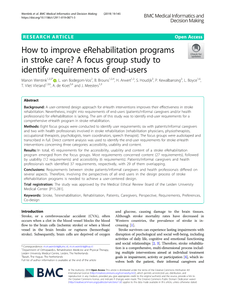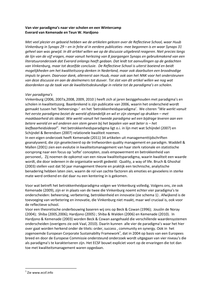De laatste decennia woedt de discussie over de vraag of ondernemingen zich uitsluitend op aandeelhouders moeten richten of op alle belanghebbenden, of zij vooral aan de korte of aan de lange termijn moeten denken, anders gezegd of zij het Angelsaksische of het Rijnlandse model moeten hanteren. Dit onderzoek probeert na te gaan hoe het onderscheid tussen deze beide modellen gemeten kan worden. Het lijkt erop, dat het verschil vooral voor de bühne bestaat. Dit suggereert, dat de twee modellen wel gebruik kunnen worden als motivatie, als ideaaltype, maar dat in de praktijk weinig mensen consequent het ene of het andere model aanhangen.
DOCUMENT

De laatste decennia woedt de discussie over de vraag of ondernemingen zich uitsluitend op aandeelhouders moeten richten of op alle belanghebbenden, of zij vooral aan de korte of aan de lange termijn moeten denken, anders gezegd of zij het Angelsaksische of het Rijnlandse model moeten hanteren. Dit onderzoek probeert na te gaan hoe het onderscheid tussen deze beide modellen gemeten kan worden. Het lijkt erop, dat het verschil vooral voor de bühne bestaat. Dit suggereert, dat de twee modellen eerder twee verschillende motivaties zijn, die leiden tot grotendeels hetzelfde gedrag.
DOCUMENT
“De Leer van het Gewekte Vertrouwen: Agency avant la lettre?” vroeg Dassen zich af in zijn artikel in het MAB van september 1989. In 1926 introduceerde Limperg zijn leer van het gewekte vertrouwen, de vertrouwensleer. Volgens Limperg is de accountant de vertrouwensman van de onpersoonlijke maatschappij, van de spaarder en van andere belanghebbenden die niet zijn opdrachtgevers zijn. Het Rijnlands model past bij deze vertrouwensleer. Dit model komt uit de West-Europese traditie en is gebaseerd op samenwerking, coöperatie en gezamenlijke waardecreatie, waarbij de belangen van alle stakeholders van een organisatie in acht worden genomen. De agency theorie is naast de vertrouwenstheorie een andere theorie voor de behoefte van de accountantscontrole. Het Angelsaksisch model gaat nauw samen met deze agency theorie. De agency theorie verklaart de behoefte aan accountantscontrole vanuit de tegengestelde belangen tussen management en aandeelhouders. Het Angelsaksisch model dat steeds meer de plaats inneemt van het Rijnlands model is een ander economisch model en is vanuit Noord-Amerika en Groot-Brittannië naar Europa overgewaaid. Beursgenoteerde bedrijven zijn steeds meer geneigd om de aandeelhouderswaarde te vermelden als zij grote aandeelhouders met een financiële achtergrond hebben, of wanneer deze aandeelhouders een Angelsaksische nationaliteit hebben. Het Angelsaksisch model is gebaseerd op marktwerking, concurrentie en eigen belang.
MULTIFILE

Het steeds terugkerende dilemma voor schoolleiders is dat van ‘sturen en loslaten’. Vanuit het Rijnlandse denken wil je docenten als vakmensen zoveel mogelijk verantwoordelijkheid geven. Maar waarop stuur je dan? Wanneer geef je ruimte? Voor schoolleiders die nog een managementniveau boven zich hebben, is dat dilemma extra ingewikkeld. De centrale kaders kunnen soms behoorlijk knellend zijn. Waar zit nog je eigen beleidsruimte? En hoe hou je ruimte voor initiatief van de docenten in je team? In dit artikel beoog ik aan de hand van de verbinding tussen Policy Governance®1 en het Rijnlandse denken een paar aanknopingspunten te bieden om met deze paradox om te gaan.
DOCUMENT

The uptake of eRehabilitation programs in stroke care is insufficient, despite the growing availability. The aim of this study was to explore which factors influence the uptake of eRehabilitation in stroke rehabilitation, among stroke patients, informal caregivers, and healthcare professionals. A qualitative focus group study with eight focus groups (6–8 participants per group) was conducted: six with stroke patients/informal caregivers and two with healthcare professionals involved in stroke rehabilitation (rehabilitation physicians, physical therapists, occupational therapists, psychologists, managers). Focus group interviews were audiotaped, transcribed in full, and analyzed by direct content analysis using the implementation model of Grol. Results Thirty-two patients, 15 informal caregivers, and 13 healthcare professionals were included. A total of 14 influencing factors were found, grouped to 5 of the 6 levels of the implementation model of Grol (Innovation, Organizational context, Individual patient, Individual professional, and Economic and political context). Most quotes of patients, informal caregivers, and healthcare professionals were classified to factors at the level of the Innovation (e.g., content, attractiveness, and feasibility of eRehabilitation programs). In addition, for patients, relatively many quotes were classified to factors at the level of the individual patient (e.g., patients characteristics as fatigue and the inability to understand ICT-devices), and for healthcare professionals at the level of the organizational context (e.g., having sufficient time and the fit with existing processes of care). Although there was a considerable overlap in reported factors between patients/informal caregivers and healthcare professionals when it concerns eRehabilitation as innovation, its seems that patients/informal caregivers give more emphasis to factors related to the individual patient, whereas healthcare professionals emphasize the importance of factors related to the organizational context. This difference should be considered when developing an implementation strategy for patients and healthcare professionals separately. https://doi.org/10.1186/s13012-018-0827-5
MULTIFILE

Background: A user-centered design approach for eHealth interventions improves their effectiveness in stroke rehabilitation. Nevertheless, insight into requirements of end-users (patients/informal caregivers and/or health professionals) for eRehabilitation is lacking. The aim of this study was to identify end-user requirements for a comprehensive eHealth program in stroke rehabilitation. Methods: Eight focus groups were conducted to identify user requirements; six with patients/informal caregivers and two with health professionals involved in stroke rehabilitation (rehabilitation physicians, physiotherapists, occupational therapists, psychologists, team coordinators, speech therapist). The focus groups were audiotaped and transcribed in full. Direct content analysis was used to identify the end-user requirements for stroke eHealth interventions concerning three categories: accessibility, usability and content. Results: In total, 45 requirements for the accessibility, usability and content of a stroke eRehabilitation program emerged from the focus groups. Most requirements concerned content (27 requirements), followed by usability (12 requirements) and accessibility (6 requirements). Patients/informal caregivers and health professionals each identified 37 requirements, respectively, with 29 of them overlapping. Conclusions: Requirements between stroke patients/informal caregivers and health professionals differed on several aspects. Therefore, involving the perspectives of all end users in the design process of stroke eRehabilitation programs is needed to achieve a user-centered design.
MULTIFILE

The shift towards a more sustainable circular economy will require innovations. While SMEs can contribute to this development, financing innovations within SMEs is difficult. Various authors have not ed moreover that the concept of the circular economy has further increased the complexity of investment decisions concerning sustainable innovations, due to the multiple value creation and new business models involved . On the other hand
DOCUMENT

Recentelijk is een discussie ontstaan over scholen in kwaliteitsmanagement, met nadruk op het verschijnsel van de reflectieve school. Van Kemenade en Hardjono pleiten voor vier scholen en van alle vier zou de kwaliteitsmanager de bijbehrende competenties oeten bezitten.
DOCUMENT

This Article presents the PSO matrix as a tool for making choices in change projects – choices for simplicity or for complexity. A good process structure is essential for a simple organization, but it is the employees and the managers who are expected to take the lead in the changes and the improvement proposals. The PSO matrix is a useful and usable instrument that promotes simplicity and respects the intelligence that is already present in the organization, particularly that of the ordinary employees. The approach leads to drastic savings. Do as much nothing as possible.
MULTIFILE

Keynote presentatie tijdens het HRM Praktijk Onderzoek Congres 14 november. Over het thema: 'De veranderende waarde(n) van werk: gevolgen voor HRMTrends in werk. Werk is veranderd en verandert nog steeds. Banen waar we 10 jaar geleden nog nooit van gehoord hadden, worden nu veelvuldig gevraagd, maar kunnen ook weer verdwijnen. De situatie op de werkvloer is niet meer te vergelijken met die van enkele decennia geleden. Er is veel meer variatie: meer vrouwen, allochtonen en parttimers, om maar eens wat te noemen. Organisaties werken tijdelijk samen aan projecten en hun medewerkers dus ook. Functies veranderen voortdurend. Hoe spelen organisatie in het algemeen en HRM in het bijzonder hier op in? Hoe bereid je medewerkers adequaat voor op voortdurende verandering? Welke consequenties hebben al die veranderingen voor het HRM beleid in organisaties?
DOCUMENT
